python3二元Logistics Regression 回归分析(LogisticRegression)
纲要
boss说增加项目平台分析方法:
T检验(独立样本T检验)、线性回归、二元Logistics回归、因子分析、可靠性分析
根本不懂,一脸懵逼状态,分析部确实有人才,反正我是一脸懵
首先解释什么是二元Logistic回归分析吧
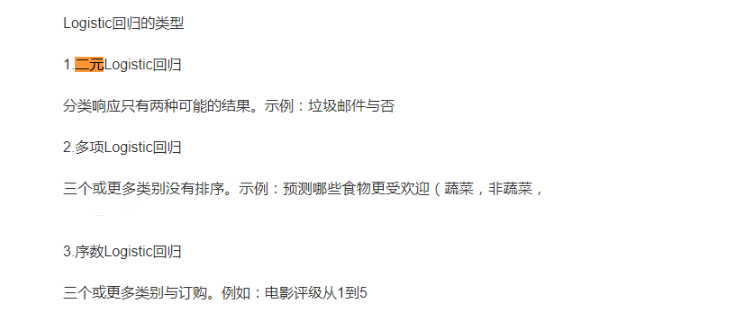
官方简介:
链接:https://pythonfordatascience.org/logistic-regression-python/

Logistic regression models are used to analyze the relationship between a dependent variable (DV) and independent variable(s) (IV) when the DV is dichotomous. The DV is the outcome variable, a.k.a. the predicted variable, and the IV(s) are the variables that are believed to have an influence on the outcome, a.k.a. predictor variables. If the model contains IV, then it is a simple logistic regression model, and if the model contains + IVs, then it is a multiple logistic regression model. Assumptions for logistic regression models: The DV is categorical (binary)
If there are more than categories in terms of types of outcome, a multinomial logistic regression should be used
Independence of observations
Cannot be a repeated measures design, i.e. collecting outcomes at two different time points.
Independent variables are linearly related to the log odds
Absence of multicollinearity
Lack of outliers
原文
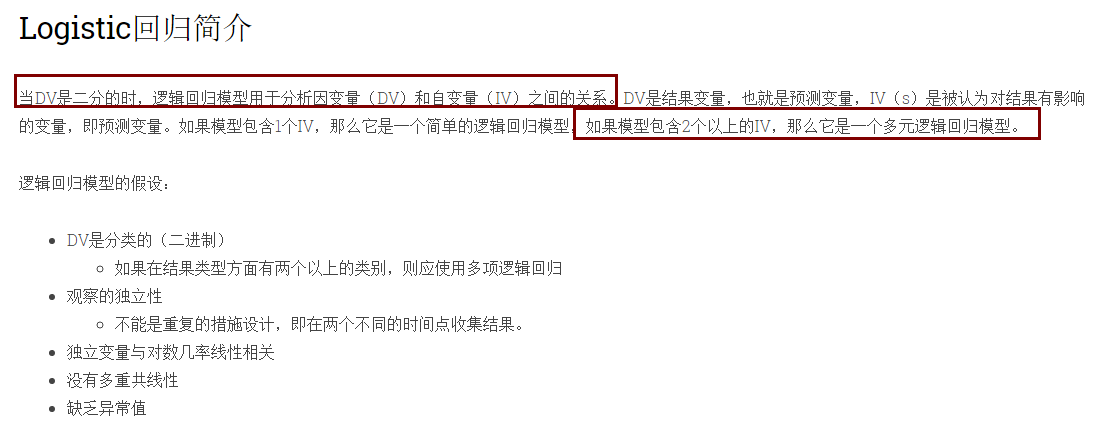
理解了什么是二元以后,开始找库
需要用的包
这里需要特别说一下,第一天晚上我就用的logit,但结果不对,然后用机器学习搞,发现结果还不对,用spss比对的值
奇怪,最后没办法,只能抱大腿了,因为他们纠结Logit和Logistic的区别,然后有在群里问了下,有大佬给解惑了
而且也有下面文章给解惑
1. 是 statsmodels 的logit模块
2. 是 sklearn.linear_model 的 LogisticRegression模块

先说第一种方法
首先借鉴文章链接:https://blog.csdn.net/zj360202/article/details/78688070?utm_source=blogxgwz0
解释的比较清楚,但是一定要注意一点就是,截距项,我就是在这个地方出的问题,因为我觉得不重要,就没加
#!/usr/bin/env
# -*- coding:utf-8 -*- import pandas as pd
import statsmodels.api as sm
import pylab as pl
import numpy as np
from pandas import DataFrame, Series
from sklearn.cross_validation import train_test_split
from sklearn.linear_model import LogisticRegression
from sklearn import metrics
from collections import OrderedDict data = {
'y': [0, 0, 0, 0, 0, 0, 0, 0, 1, 0, 0, 1, 0, 0, 1, 0, 1, 1, 1, 1],
'x': [i for i in range(1, 21)],
} df = DataFrame(OrderedDict(data)) df["intercept"] = 1.0 # 截距项,很重要的呦,我就错在这里了 print(df)
print("==================")
print(len(df))
print(df.columns.values) print(df[df.columns[1:]]) logit = sm.Logit(df['y'], df[df.columns[1:]])
#
result = logit.fit()
#
res = result.summary2() print(res)
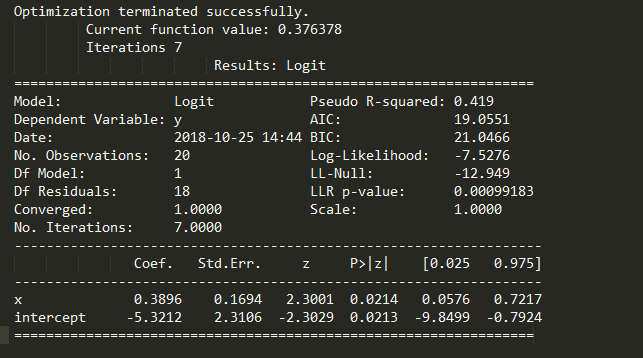
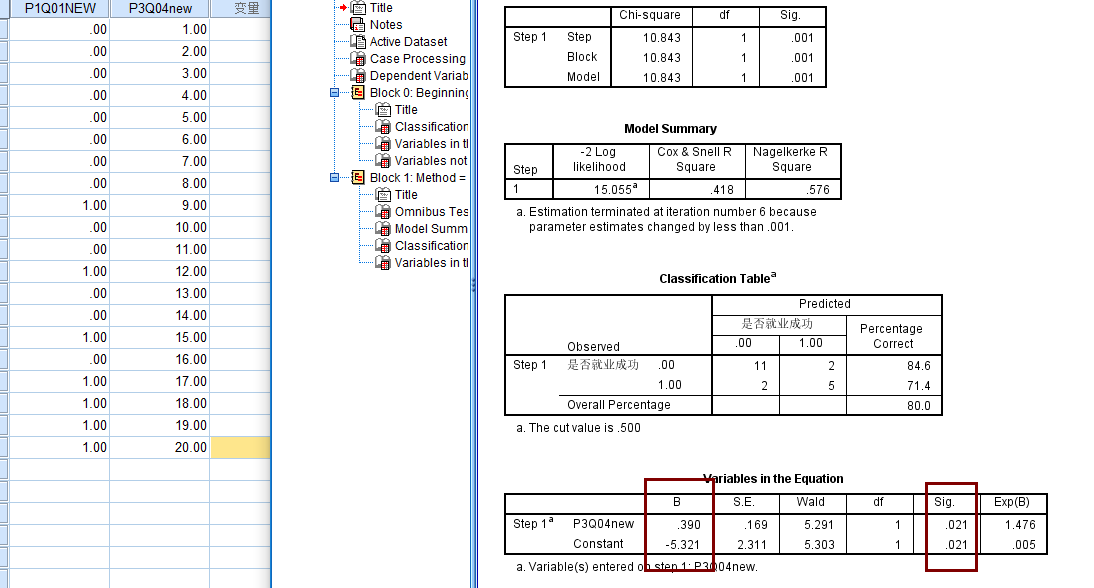
这么写我觉得更好,因为上面那么写执行第二遍的时候总是报错:
statsmodels.tools.sm_exceptions.PerfectSeparationError: Perfect separation detected, results not available
我改成x, y变量自己是自己的,就莫名其妙的好了
obj = TwoDimensionalLogisticRegressionModel()
data_x = obj.SelectVariableSql( UserID, ProjID, QuesID, xVariable, DatabaseName, TableName, CasesCondition)
data_y = obj.SelectVariableSql( UserID, ProjID, QuesID, yVariable, DatabaseName, TableName, CasesCondition)
if len(data_x) != len(data_y):
raise MyCustomError(retcode=4011)
obj.close() df_X = DataFrame(OrderedDict(data_x))
df_Y = DataFrame(OrderedDict(data_y)) df_X["intercept"] = 1.0 # 截距项,很重要的呦,我就错在这里了
logit = sm.Logit(df_Y, df_X)
result = logit.fit()
res = result.summary() data = [j for j in [i for i in str(res).split('\n')][-3].split(' ') if j != ''][1:] return data
允许二分数值虚拟变量的使用,修改后
obj = TwoDimensionalLogisticRegressionModel()
data_x = obj.SelectVariableSql( UserID, ProjID, QuesID, xVariable, DatabaseName, TableName, CasesCondition)
data_y = obj.SelectVariableSql( UserID, ProjID, QuesID, yVariable, DatabaseName, TableName, CasesCondition)
if len(data_x) != len(data_y):
raise MyCustomError(retcode=)
obj.close() df_X = DataFrame(data_x)
df_Y = DataFrame(data_y) # 因变量,, df_X["intercept"] = 1.0 # 截距项,很重要的呦,我就错在这里了 YColumnList = list(df_Y[yVariable].values)
setYColumnList = list(set(YColumnList))
if len(setYColumnList) > or len(setYColumnList) < :
raise MyCustomError(retcode=)
else:
if len(setYColumnList) == and [,] != [int(i) for i in setYColumnList]:
newYcolumnsList = []
for i in YColumnList:
if i == setYColumnList[]:
newYcolumnsList.append()
else:
newYcolumnsList.append()
df_Y = DataFrame({yVariable:newYcolumnsList})
logit = sm.Logit(df_Y, df_X)
result = logit.fit()
res = result.summary() data = [j for j in [i for i in str(res).split('\n')][-].split(' ') if j != ''] return data[:]
再次更新后
def TwoDimensionalLogisticRegressionDetail(UserID, ProjID, QuesID, xVariableID, yVariableID, CasesCondition):
two_obj = TwoDimensionalLogisticModel()
sql_data, xVarName, yVarName = two_obj.showdatas(UserID, ProjID, QuesID, xVariableID, yVariableID, CasesCondition) two_obj.close() df_dropna = DataFrame(sql_data).dropna()
df_X = DataFrame()
df_Y = DataFrame() # 因变量,0, 1 df_X[xVarName] = df_dropna[xVarName]
df_Y[yVarName] = df_dropna[yVarName] df_X["intercept"] = 1.0 # 截距项,很重要的呦,我就错在这里了 YColumnList = list(df_Y[yVarName].values)
setYColumnList = list(set(YColumnList)) # print(setYColumnList)
if len(setYColumnList) > 2 or len(setYColumnList) < 2:
raise MyCustomError(retcode=4015)
# else:
if len(setYColumnList) == 2 and [0, 1] != [int(i) for i in setYColumnList]:
newYcolumnsList = []
for i in YColumnList:
if i == setYColumnList[0]:
newYcolumnsList.append(0)
else:
newYcolumnsList.append(1)
df_Y = DataFrame({yVarName: newYcolumnsList})
logit = sm.Logit(df_Y, df_X)
res = logit.fit()
res_all = res.summary()
LogLikelihood = [i.strip() for i in str(res_all).split("\n")[6].split(" ") if i][3]
# 没找到具体参数, 只能这么分割
index_var = [i.strip() for i in str(res_all).split("\n")[12].split(" ") if i]
intercept = [i.strip() for i in str(res_all).split("\n")[13].split(" ") if i]
std_err = [index_var[2], intercept[2]]
z = [index_var[3], intercept[3]]
P_z = [index_var[4], intercept[4]] # 显著性
interval_25 = [index_var[5], intercept[5]]
interval_975 = [index_var[6], intercept[6]]
Odds_Ratio = [math.e ** i for i in list(res.params)]
return {
"No_Observations": res.nobs,#No. Observations
"Pseudo_R": res.prsquared,# Pseudo R^2
"Log_Likelihood": LogLikelihood, # LogLikelihood
"LLNull": res.llnull,
"llr_pvalue": res.llr_pvalue, #llr显著性
"coef": list(res.params), # 系数
"std_err": std_err,
"Odds_Ratio": Odds_Ratio,
"z": z,
"P": P_z, #显著性
"interval_25": interval_25, # 区间0.025
"interval_975": interval_975
}
第二种方法,机器学习
参考链接:https://zhuanlan.zhihu.com/p/34217858
#!/usr/bin/env python
# -*- coding:utf-8 -*- from collections import OrderedDict
import pandas as pd examDict = {
'学习时间': [i for i in range(1, 20)],
'通过考试': [0, 0, 0, 0, 0, 0, 0, 0, 1, 0, 0, 1, 0, 0, 1, 0, 1, 1, 1]
} examOrderDict = OrderedDict(examDict)
examDF = pd.DataFrame(examOrderDict)
# print(examDF.head()) exam_X = examDF.loc[:, "学习时间"]
exam_Y = examDF.loc[:, "通过考试"] print(exam_X)
# print(exam_Y) from sklearn.cross_validation import train_test_split X_train,X_test,y_train, y_test = train_test_split(exam_X,exam_Y, train_size=0.8) # print(X_train.values)
print(len(X_train.values))
X_train = X_train.values.reshape(-1, 1)
print(len(X_train))
print(X_train)
X_test = X_test.values.reshape(-1, 1) from sklearn.linear_model import LogisticRegression module_1 = LogisticRegression()
module_1.fit(X_train, y_train) print("coef:", module_1.coef_) front = module_1.score(X_test,y_test)
print(front) print("coef:", module_1.coef_)
print("intercept_:", module_1.intercept_) # 预测
pred1 = module_1.predict_proba(3)
print("预测概率[N/Y]", pred1) pred2 = module_1.predict(5)
print(pred2)
但是,机器学习的这个有问题,就是只抽取了15个值
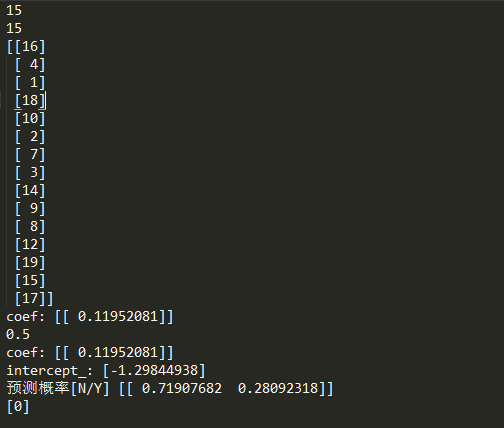
statsmodels的库链接
Statsmodels:http://www.statsmodels.org/stable/index.html
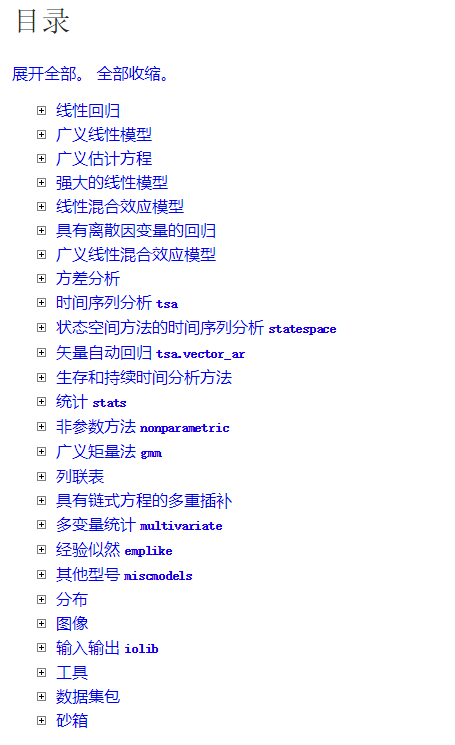
python3二元Logistics Regression 回归分析(LogisticRegression)的更多相关文章
- 1.2、Logistics Regression算法实践
1.1.Logistics Regression算法实践 有了上篇博客的理论准备后,接下来,我们用以及完成的函数,构建Logistics Regression分类器.我们利用线性可分的数据作为训练样 ...
- 1.1、Logistics Regression模型
1.线性可分VS线性不可分 对于一个分类问题,通常可以分为线性可分与线性不可分两种 .如果一个分类问题可以使用线性判别函数正确的分类,则称该问题为线性可分.如图所示为线性可分,否则为线性不可分: 下图 ...
- logistics regression
logistics regression用于解决一些二分类问题.比如(纯假设)网上购物时,网站会判断一个人退货的可能性有多大,如果该用户退货的可能性很大,那么网站就不会推荐改用户购买退费险.反之,如果 ...
- Popular generalized linear models|GLMM| Zero-truncated Models|Zero-Inflated Models|matched case–control studies|多重logistics回归|ordered logistics regression
============================================================== Popular generalized linear models 将不同 ...
- python进行数据分析
1. python进行数据分析----线性回归 2. python进行数据分析------相关分析 3. python进行数据分析---python3卡方 4. 多重响应分析,多选题二分法思路 5. ...
- Logistic Regression Vs Decision Trees Vs SVM: Part I
Classification is one of the major problems that we solve while working on standard business problem ...
- logistics回归简单应用(二)
警告:本文为小白入门学习笔记 网上下载的数据集链接:https://pan.baidu.com/s/1NwSXJOCzgihPFZfw3NfnfA 密码: jmwz 不知道这个数据集干什么用的,根据直 ...
- 2.1、Softmax Regression模型
Softmax Regression模型 由于Logistics Regression算法复杂度低,容易实现等特点,在工业中的到广泛的使用,但是Logistics Regression算法主要用于处理 ...
- 【R语言进行数据挖掘】回归分析
1.线性回归 线性回归就是使用下面的预测函数预测未来观测量: 其中,x1,x2,...,xk都是预测变量(影响预测的因素),y是需要预测的目标变量(被预测变量). 线性回归模型的数据来源于澳大利亚的C ...
随机推荐
- 安装Appium-desktop,并连接模拟器!Appium-Python-Client
1.下载appium-desktop https://github.com/appium/appium-desktop/releases 2.双击 exe 文件,然后,等待安装完就好了 3.启动app ...
- 浅表拷贝vs深度拷贝
浅表复制,只是创建所有的值类型,所有的引用类型还是会指向被复制的对象的引用. 故,当被复制的对象的引用类型发生改变的同事,复制的对象相应的 引用类型的值也是会发生改变的. 所以事件字段也是一个引用类型 ...
- window + php + memcached 安装
第一步:安装windows版memcached 下载地址:http://download.csdn.net/detail/zhaotengfei36520/8182503#comment 下载之后将文 ...
- oracle case when 用法
原文:http://www.cnblogs.com/eshizhan/archive/2012/04/06/2435493.html 1. CASE WHEN 表达式有两种形式 --简单Case函数 ...
- spring cloud——feign为GET请求时的对象参数传递
一.问题重现 楼主在使用feign进行声明式服务调用的时候发现,当GET请求为多参数时,为方便改用DTO对象进行参数传递.但是,在接口调用时feign会抛出一个405的请求方式错误: {"t ...
- CentOS -- 添加开机自启动 命令 脚本
如果只是添加一条开机启动的命令: 1. chmod +x /etc/rc.d/rc.local 2. 将命令写到 /etc/rc.d/rc.local 这个文件中 3. reboot
- UVA 11613 Acme Corporation(不固定流量的最小费用流)
题意好长....变量好多.... 增加源点跟汇点.然后将每个月份看成一个点,然后拆成两个点u 跟 u+n. 从s向每个u连一条<n[u], m[i]>的弧,表示最多生产量及价值. 从每个u ...
- 小程序canvas的一个坑
很奇怪,原来好好的,结果现在显示乱了,模拟器和手机都不一样.模拟器上,整个canvas都往右偏移了,手机上,右侧有一大片空白. 反复试验,发现问题是:page的对齐方式是center引起的,改为lef ...
- js 创建Date对象5种方式
new Date("month dd,yyyy hh:mm:ss"); new Date("month dd,yyyy"); new Date(yyyy,mth ...
- 微软BI 之SSIS 系列 - 理解Data Flow Task 中的同步与异步, 阻塞,半阻塞和全阻塞以及Buffer 缓存概念
开篇介绍 在 SSIS Dataflow 数据流中的组件可以分为 Synchronous 同步和 Asynchronous 异步这两种类型. 同步与异步 Synchronous and Asynchr ...
